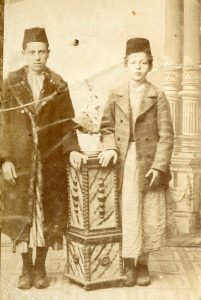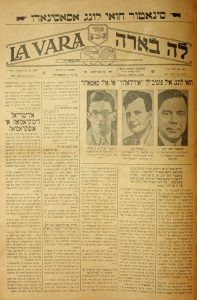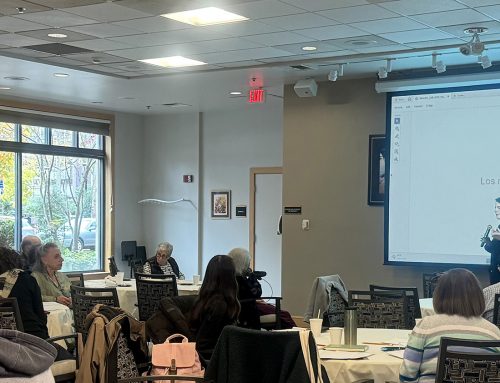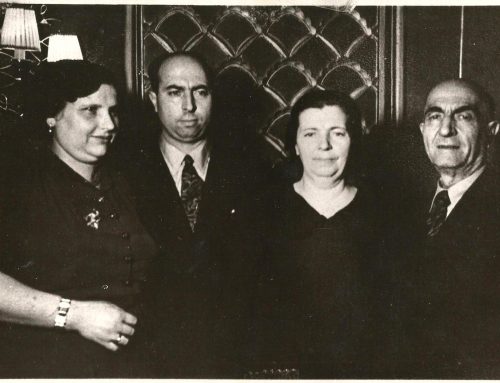
Family photograph from the Covo and Youchah Collection, courtesy of Elayna J. Youchah (ST01136)
As the Ladino refran, or proverb, tells us: Un anyo mas, un sehel mas. Another year, another piece of knowledge. This is certainly true for the Sephardic Studies Program, which has completed its third year of sharing knowledge with, and gaining knowledge from, students, scholars, and community members in Seattle and across the world. The increased enthusiasm and interest is reflected in the numerous media outlets that have profiled our endeavors, from The UW Daily and The Seattle Times to The Jewish Telegraphic Agency, The Jewish Daily Forward, Mosaic Magazine, and myjewishlearning.com.
Research
Our Sephardic Studies digital library and archive continues to grow. Not only do we have more Ladino books than the Library of Congress or Harvard University, but we have succeeded in digitizing 1,445 Sephardic “treasures” contributed by local community members: nearly 600 books, magazines, and newspapers; more than 400 archival documents including family correspondence, postcards, photographs, immigration documents, institutional records, theater scripts, amulets, and marriage certificates; and more than 200 audio and video recordings. All told, to date we have scanned 132,236 pages of Sephardic material. We are now a “big data” operation. A sampling of more than 40 of these sources are available online for free to anyone with an internet connection and have already been visited by thousands of users.
Working with Ty Alhadeff – who serves as our archivist, librarian, accession officer, blogger, social media strategist, and student research resource – we have published a series of more than twenty online essays on the Stroum Center website. These essays, by staff, faculty, and students, highlight Sephardic themes, artifacts, or personalities and situate them within the relevant cultural and historical context accompanied by images and translations from original Ladino sources. Focused on Sephardic customs and cuisine, songs and oral traditions, military service and war, migration and refugees, publishing and education, rabbis and teachers, and the roles of men and women, the posts open new vistas on the Sephardic experience; they have attracted 77,345 visitors.

Aliza Benaroya’s travel document, courtesy of her daughter Judith Amiel (ST00264)
Teaching
Last year, thanks to a course on medieval Sephardic culture taught by Professor Ana Gómez-Bravo and another by me, on Sephardic history after 1492, undergraduate and Access students delved into a millennium of the Sephardic experience from Spain to the Middle East, America, and beyond. Recent undergraduate projects have included a study of Sephardic identity in Seattle; the history of the Rhodes Holocaust monument; the relationship between Sephardic and Arab-Jewish identity; and the debates over whether Sephardic Jews should apply for Spanish or Portuguese citizenship today.
Graduate students in History, Linguistics, Near and Middle East Studies, and Near Eastern Languages and Civilizations continue their innovative, multidisciplinary work in Sephardic Studies. Sarah Zaides Rosen completed her dissertation on the encounter between Ashkenazi and Sephardi Jews in Istanbul; Molly FitzMorris continues her study of the Rhodes dialect of Ladino; Canan Bolel is on fellowship in Turkey for her research on the Jews of Izmir; and, having already completed his dissertation, Oscar Aguirre Mandujano is preparing an exhibition of Sephardic artifacts in Seattle to be displayed in Istanbul.
Community Engagement
Our Fourth Annual Ladino Day celebration involved a screening of the 1978 film, Song of the Sephardi, which profiled Sephardic life in Seattle forty years ago, followed by a multigenerational panel of community leaders (Hazan Isaac Azose, Judith Amiel, David Behar, and Makena Owens) who discussed the past, present, and future of Ladino. Are there more verses to the “song of the Sephardi” yet to be written or has the language been condemned to extinction? With 300 attendees, the event concluded with Sephardic treats. Other events such as a celebration of my new book, Jewish Salonica, and our annual Sephardic Spotlight at the Seattle Jewish Film Festival, drew together hundreds more.

Front page of the La Vara newspaper from the Albert Adatto Collection, courtesy of his son Richard Adatto (ST01101)
We have also cultivated a worldwide virtual Sephardic Studies community. Our Facebook page has become a key international go-to resource for all things Sephardic. Our 3,700 “friends” hail from 45 countries in addition to the US, including Israel, Turkey, Greece, England, France, Brazil, Spain, Canada, Italy, Germany, Argentina, Hungary, South Africa, Columbia, Mexico, Belgium, Peru, and Japan. We remain grateful for the support of the Stroum Center for Jewish Studies and its staff, as well as the Jackson School of International Studies and our many partners on and off campus. Finally, our endeavors are made possible with the generous contributions of our supporters, and especially the Sephardic Studies Founders Circle. Mersi muncho! May 2017- 2018 be another year with more knowledge shared and more knowledge gained. Adelantre!
[Editors note: This essay originally appeared in the UW’s Stroum Center for Jewish Studies 2017 Impact Report, published in the autumn of 2017]







Leave A Comment